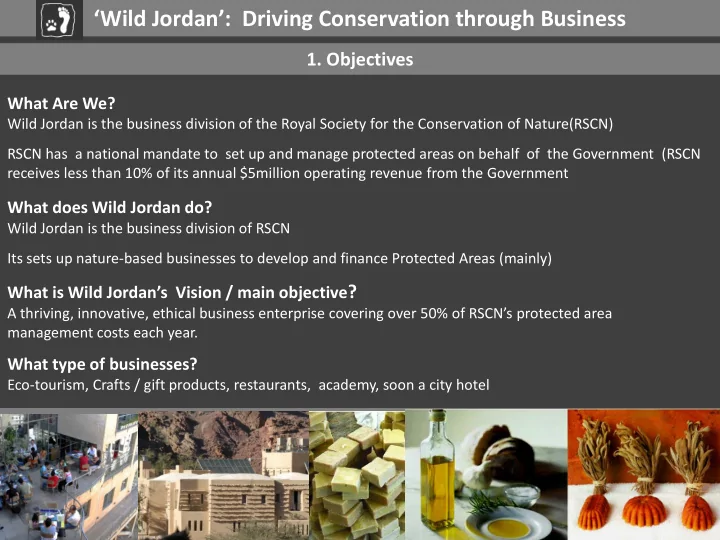

‘Wild Jordan’: Driving Conservation through Business 1. Objectives What Are We? Wild Jordan is the business division of the Royal Society for the Conservation of Nature(RSCN) RSCN has a national mandate to set up and manage protected areas on behalf of the Government (RSCN receives less than 10% of its annual $5million operating revenue from the Government What does Wild Jordan do? Wild Jordan is the business division of RSCN Its sets up nature-based businesses to develop and finance Protected Areas (mainly) What is Wild Jordan’s Vision / main objective ? A thriving, innovative, ethical business enterprise covering over 50% of RSCN’s protected area management costs each year. What type of businesses? Eco-tourism, Crafts / gift products, restaurants, academy, soon a city hotel
‘Wild Jordan’: Driving Conservation through Business 2. Sources of Finance / Volumes and Trends Where do we get our finance from? For business start-up, mainly from donors and sponsors: includes capital & initial staffing and operating costs. (e.g. USAID, GEF, EU, Private Banks – ‘Development Aid’) For ongoing development and day-to-day operations, from business revenues Increasingly outsourcing operations to the private sector What ‘s the scale of Wild Jordan’s business operations? In 2010 , generated $800,000 net revenue to support conservation costs, mainly from tourism. This represented close to 50% of the total protected area cost centre budgets Over 16,000 people from poor rural communities supported directly and indirectly Aim for a 10-15% return on investment, although may start with lower Trends Since business operations began in 1994, growth in revenue has been between 15-20% per year, except in years of serious political unrest, including 2011 and this year because of the ‘Arab Spring’ (impacts on tourist numbers)
no. of staff Expenses Revenues Net Total Dana Reserve Management 16 146,575 4,800 -141,775 Dana Guest House 10 123,693 161,064 37,371 Rummanah Campsite 11 108,665 126,694 18,029 Feynan Eco-Lodge 23 0 40,036 40,036 Total 60 -46,339 % of Conservation cost cover from Tourism 67%
‘Wild Jordan’: Driving Conservation through Business 3. Opportunities to Scale-up Where can we go from here? Already working nationally, in almost every protected area Soon, Wild Jordan will be re-engineered as an entirely separate business entity (as opposed to a division of RSCN), with its own charter, board of directors, management ethos and salary scale. Scaling-up is planned through: (i) A more broad-based business strategy, investing in innovative ventures outside protected areas that make good business sense: e.g. city boutique hotels, franchising the Wild Jordan Café as a national ‘chain’ (ii) More partnerships with the private sector; more outsourcing (iv) Development of business models for each protected area.
Wild Jordan Boutique Hotel: Architect’s Rendition
‘Wild Jordan’: Driving Conservation through Business 4. Key challenges Environmental effectiveness As Wild Jordan’s (new) primary aim is to finance the work of RSCN, environmental effectiveness will be judged by how profitable we are and how cost effective Challenges to profitability and cost effectiveness Scale of overheads . These tend to be large in an ‘ethical business’, where the employment of local communities is paramount and sites are distant from centres of population. ROI’s are difficult to assess if you are pioneering business enterprises in situations where they’ve not been attempted before. Therefore difficult to get private sector investors and venture capital. High “conservation "premiums or commissions on private sector agreements can deter investors. Perceptions of business and private sector are often negative in local communities, government players and the staff of conservation organisations. Government’s often see them as inimical to the principal of “common property”: e.g. Protected areas are for everyone’s benefit (the issue of equity – out pricing the poor and restricting their access to biodiversity assets) The difficultly of finding competent, innovative business managers, marketing and sales people that understand nature-based business and feel a commitment to them.
‘Wild Jordan’: Driving Conservation through Business 5. Hindsight What would we do differently? Better business planning and management. Separate business operations from the parent NGO much sooner Create business investments / operations for generating profit , divorced from a direct relationship with the target biodiversity resource and use the profit to support the financing of biodiversity conservation programs . Have a greater variety of pricing options for facilities and services in protected areas that are affordable for lower income groups Devote more time to advocacy, education and PR to change perspectives on using business as a financing mechanism for biodiversity Engage the private sector in the development of business ideas
Recommend
More recommend